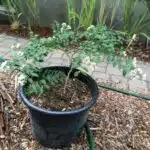Angel’s Trumpet, also known as Pricklyburr, is a stunning flowering plant that belongs to the Solanaceae family. This tropical plant is native to South America and can be grown outdoors in warmer climates or indoors in colder regions. With its trumpet-shaped flowers and sweet fragrance, Angel’s Trumpet has become a popular choice among gardeners and horticulturists.
In order to successfully grow and care for Angel’s Trumpet, it is important to understand its unique characteristics and requirements. From proper soil conditions to adequate watering techniques, there are several factors that must be considered when cultivating this beautiful plant. In this article, we will discuss the best practices for growing and caring for Angel’s Trumpet, including tips on pruning, fertilizing, and pest control. Whether you are a seasoned gardener or new to horticulture, this guide will provide valuable information on how to ensure your Angel’s Trumpet thrives and produces beautiful blooms.
Understanding The Solanaceae Family
The Solanaceae family is a diverse group of plants that includes several important food crops, such as tomatoes, potatoes, and peppers. It also includes many ornamental plants, such as petunias, morning glories, and angel’s trumpets (pricklyburr). The taxonomy of this family has been the subject of much debate over the years, but it is generally agreed that there are around 90 genera and 3,000 species in the Solanaceae family.
One interesting aspect of the Solanaceae family is its medicinal properties. Many members of this family have been used for centuries by various cultures to treat a variety of ailments. For example, belladonna (Atropa belladonna) was used by ancient Greeks and Romans as a sedative and painkiller. Another well-known member of this family is tobacco (Nicotiana tabacum), which contains the stimulant nicotine.
When it comes to growing angel’s trumpets (pricklyburr), understanding their relationship to other members of the Solanaceae family can be helpful. These plants are typically grown for their large, trumpet-shaped flowers that bloom in shades of pink, white, yellow, or orange. They prefer warm temperatures and plenty of sunlight to thrive. In the next section, we will discuss how to choose the right location for your angel’s trumpet plant.
Choosing The Right Location
When it comes to growing and caring for angel’s trumpet, one of the most important considerations is choosing the right location. This plant thrives in warm, humid environments, making it an ideal choice for gardeners living in tropical or subtropical regions. However, even if you live in a cooler climate, with the right care and attention, you can still grow this beautiful plant.
When selecting a location for your angel’s trumpet plant, it is important to consider soil composition. These plants prefer well-drained soil that is rich in organic matter. If your soil tends to be heavy or clay-like, consider amending it with compost or other organic materials to improve drainage and nutrient content. Additionally, make sure that the area you choose receives plenty of sunlight throughout the day.
Climate considerations are also important when choosing a location for your angel’s trumpet plant. As mentioned earlier, these plants thrive in warm, humid environments. If you live in an area with cool winters or dry summers, you may need to take extra steps to protect your plant from cold temperatures or drought conditions. Consider planting your angel’s trumpet near a south-facing wall or other protected area to help shield it from harsh weather conditions.
Providing adequate sunlight is crucial for the health and growth of your angel’s trumpet plant. In the next section, we will explore some tips for ensuring that your plant receives enough light each day to thrive and flourish. With careful attention and proper care, your angel’s trumpet can become a stunning addition to any garden or landscape design.
Providing Adequate Sunlight
- When selecting a location for growing angel’s trumpet (pricklyburr), it is important to consider the amount of light the plants will receive.
- The ideal situation is to plant the plants in a location that receives full sun.
- If this is not possible, then partial sun can be accepted, but the plants should still be able to receive several hours of direct sunlight each day.
- When planting in sunlight, it is important to monitor the amount of sun exposure the plants receive.
- Too much sun can cause the plants to become scorched, and too little sun can cause them to become weak and not flower.
- Monitoring the amount of sun exposure can be done by observing the plants and their foliage and adjusting the amount of sun accordingly.
Choosing A Location
When it comes to growing and caring for angel’s trumpet, choosing the right location is crucial. This beautiful plant thrives in warm and sunny environments, making microclimate considerations an important factor to keep in mind. Before selecting a spot for your angel’s trumpet, take note of the amount of sunlight it will receive throughout the day. Ideally, it should be placed in an area that gets at least six hours of direct sunlight daily.
Container gardening options are also available for those who have limited space or want to grow their angel’s trumpet indoors. When using containers, it’s important to choose one that is large enough for the plant’s root system and provides adequate drainage. Additionally, consider placing a saucer under the container to catch any excess water and prevent root rot.
Ultimately, finding the perfect location for your angel’s trumpet involves careful consideration of its specific needs. With proper placement and care, this stunning plant can provide you with years of enjoyment and beauty. Remember to take into account microclimate considerations and container gardening options when choosing a location to ensure your angel’s trumpet receives adequate sunlight and grows healthy over time.
Planting In Sunlight
Providing adequate sunlight is one of the most important factors to consider when growing angel’s trumpet. The plant thrives in warm and sunny environments, making it essential to choose the right location for planting. Sunlight exposure is crucial for the growth and development of this stunning plant, and insufficient light can lead to stunted growth or even death.
When planting angel’s trumpet, it’s important to avoid areas with too much shade. While some dappled shade may be beneficial during the hottest part of the day, too much shade can hinder its growth and flowering potential. It’s also important to note that even if a spot seems sunny at first glance, other factors like nearby trees or buildings can create shady areas throughout the day.
If you’re limited on space or don’t have access to a full-sun location, there are shade options available for growing angel’s trumpet. Some gardeners have had success growing it in containers that can be moved around as needed for optimal sunlight exposure. Others have found success with using shading cloths or other protective coverings to regulate the amount of light their plants receive. Whatever option you choose, just remember that finding the right balance between sun and shade is key to ensuring your angel’s trumpet thrives.
Monitoring Sun Exposure
As a horticulture expert, providing adequate sunlight is crucial when growing angel’s trumpet plants. However, it’s equally important to monitor the plant’s sun exposure regularly. This is because too much or too little sunlight can negatively impact its growth and development, affecting its overall health and flowering potential.
One way to monitor sun exposure is by using shade cloth. This material can be placed over the plant during the hottest part of the day to protect it from direct sunlight. Using shade cloth can help prevent leaf scorching and dehydration, which are common problems that occur when the plant receives too much sun exposure.
Another factor to consider when monitoring sun exposure is proper watering schedule. Angel’s trumpet needs regular watering to thrive but overwatering or underwatering can also affect its health. Too much water can cause root rot while too little water can result in stunted growth and wilted leaves. It’s important to keep an eye on soil moisture levels and adjust watering frequency based on environmental conditions such as temperature and humidity.
In conclusion, monitoring angel’s trumpet plants’ sun exposure is just as essential as providing adequate sunlight for their growth and development. Using shade cloth and ensuring proper watering schedule are two effective ways to monitor its sun exposure levels. By doing so, gardeners can ensure that their angel’s trumpet plants remain healthy and vibrant all season long.
Selecting The Proper Soil
Providing adequate sunlight is crucial for the growth and development of Angel’s Trumpet. However, selecting the proper soil is equally important. Before planting, it is essential to prepare the soil correctly to ensure that your plant gets all the nutrients it needs.
Soil Preparation:
- Choose a well-drained soil that is rich in organic matter.
- Mix in compost or aged manure to improve soil structure and fertility.
- Ensure good drainage by adding coarse sand or perlite if necessary.
- Avoid heavy soils that retain water as they can lead to root rot.
Soil pH: Angel’s Trumpet prefers slightly acidic soil with a pH range between 6.0-7.5. Test your soil before planting and adjust it accordingly using lime or sulfur.
By preparing the soil adequately, you are setting up your Angel’s Trumpet for success. The right type of soil will ensure that your plant gets all the necessary nutrients and water without any risk of root rot or other fungal diseases associated with poor drainage. In the next section, we will discuss watering techniques that will keep your Angel’s Trumpet healthy and thriving throughout its life cycle.
Watering Techniques
As a horticulture expert, I have learned that while angel’s trumpet plants are hardy, they require adequate watering to thrive. It is important to note that the frequency of watering depends on factors such as temperature, humidity, and soil type. In general, it is recommended that you water your plant once every two weeks in the winter and once a week during the growing season.
However, overwatering can be detrimental to angel’s trumpet plants. Watering too frequently can lead to root rot and other problems associated with excess moisture. To avoid this, ensure that the soil is well-draining and never allow water to pool around the roots. One way to check soil moisture levels is by inserting a finger into the soil up to your knuckle. If it feels dry at this depth, then it is time to water.
Remember that while watering frequency is important for angel’s trumpet plants’ care, so is consistency. Stick to a regular schedule and only adjust watering frequency if necessary due to changes in environmental conditions or plant health issues. Proper watering techniques will help your plant thrive and prepare it for optimal growth through fertilizing – our next section topic.
Fertilizing For Optimal Growth
Watering is essential for the growth and survival of Angel’s Trumpet plants. The frequency and amount of watering depend on various factors such as soil type, temperature, humidity, and sunlight exposure. It is crucial to keep the soil moist but not waterlogged to prevent root rot. One way to ensure proper watering is to stick your finger into the soil about an inch deep. If it feels dry, then it’s time to water.
Fertilizing your Angel’s Trumpet plant will help it grow faster and produce more blooms. Organic options are a great choice since they provide nutrients in a slow-release form that won’t burn the plant’s roots. You can use compost or worm castings as a natural fertilizer that provides essential micronutrients to the plant. A frequency schedule for fertilization depends on several factors such as plant age, growth rate, and pot size. Generally, fertilizing once every two weeks during the growing season will suffice.
Pruning your Angel’s Trumpet is crucial for shape and health purposes. Pruning encourages new growth by removing dead or diseased branches while also shaping the plant into a desired form. It also helps manage its size, which can be beneficial if you have limited space in your garden or home. Pruning should be done during early spring or late winter when the plant is dormant since it promotes robust growth during the active growing season that follows. It is essential to use sharp pruning shears to avoid damaging healthy branches while cutting away unwanted parts of the plant.
Transition sentence: Now that we have discussed fertilizing techniques let us move onto pruning for shape and health purposes.
Pruning For Shape And Health
Did you know that regular pruning can significantly enhance the health and beauty of your angel’s trumpet? Pruning frequency and shaping techniques are crucial factors in determining the overall health and appearance of your plant. In general, it is recommended to prune your angel’s trumpet once every year to remove dead, diseased, or damaged foliage.
When it comes to shaping techniques, there are various options available depending on your preferences. For instance, you may opt for a tree-like shape by removing all side branches and leaving only one central trunk. Alternatively, you may choose a shrub-like form by allowing multiple stems to grow from the base. Regardless of the technique used, it is essential to avoid over-pruning since this can lead to stunted growth or even death.
Proper pruning not only enhances the aesthetic appeal of your angel’s trumpet but also helps ward off pests and diseases. Removing dead or diseased tissue can prevent insects and pathogens from taking hold on your plant. Additionally, pruning helps increase air circulation around the plant, reducing humidity levels that favor fungal growth. By following these tips on pruning frequency and shaping techniques, you can enjoy a healthy and visually stunning angel’s trumpet for years to come.
To further protect your angel’s trumpet from pests and diseases, there are several preventative measures you should take. These include maintaining proper soil moisture levels, avoiding overcrowding plants, inspecting regularly for signs of infestation or disease, and treating any issues promptly with appropriate insecticides or fungicides. With these steps in mind, you can keep your plant healthy while also minimizing the need for more aggressive treatments down the road.
Preventing Pests And Diseases
Keeping pests and diseases at bay is a crucial aspect of caring for angel’s trumpet plants. These plants are prone to attacks from various insects, including spider mites, mealybugs, and whiteflies. Additionally, they may suffer from fungal or bacterial infections that can cause severe damage to the foliage.
One effective way to prevent pest infestations is by keeping your plant healthy. Adequate watering, fertilizing, and pruning can go a long way in promoting plant health. Natural remedies such as neem oil or insecticidal soap can be used to control minor pest problems. However, if the infestation is severe or persistent, chemical treatments may be necessary.
To further prevent diseases, it is essential to avoid overwatering and ensure proper drainage. Also, remove any infected leaves promptly and dispose of them away from the plant to prevent the spread of disease. If chemical treatment is needed for diseases such as leaf spot or blight, copper-based fungicides can be effective.
- Seeing your angel’s trumpet plant wither away due to pests or diseases can be frustrating.
- Taking preventative measures such as regular pruning can save you time and money in the long run.
- Using natural remedies over harsh chemicals can promote a healthier environment for both you and your plant.
- Keeping up with regular maintenance tasks shows dedication to providing care for your angel’s trumpet plant.
Moving on to propagation methods…
Propagation Methods
To prevent pests and diseases from affecting your angel’s trumpet plant, it is important to maintain proper care and hygiene. Always ensure that your plant is not overwatered, as this can lead to root rot and attract pests such as fungus gnats. Additionally, regularly check for signs of pests or disease, such as wilting leaves or discolored spots on the foliage. If you do notice any issues, address them immediately with appropriate treatments.
Once you have successfully grown your angel’s trumpet plant, you may want to propagate it to share with others or expand your collection. One propagation method that works well for this plant is water propagation. Simply take a cutting from the parent plant and place it in a jar of water until roots begin to form. Once the roots are established, transfer the cutting to soil.
Another propagation technique that can be used for angel’s trumpet plants is division. This involves carefully separating the root ball of an established plant into sections and replanting each section in its own pot or location. This allows you to create multiple plants from one parent plant while also promoting healthy growth by preventing overcrowding.
| Propagation Method | Benefits |
|---|---|
| Water Propagation | Easy method for beginners; allows for observation of root growth |
| Division | Promotes healthy growth; creates multiple plants from one parent |
As an expert in horticulture, it is essential to understand different methods of propagating plants so that they can be shared with others or expanded upon in one’s own collection. By utilizing water propagation or division techniques, gardeners can easily propagate their angel’s trumpet plants without having to purchase new ones from a nursery. These methods also promote healthy growth and help prevent issues such as overcrowding within pots. In the next section, we will discuss troubleshooting common issues that may arise when caring for angel’s trumpet plants.
Troubleshooting Common Issues
Identifying pests is a crucial step in troubleshooting angel’s trumpet plants. Common pests that infest this plant include spider mites, aphids, and mealybugs. Spider mites are tiny arachnids that feed on the plant’s sap, causing discoloration and weakening of its leaves. Aphids suck the sap from the plant, leading to distorted growth and yellowing of leaves. Mealybugs also feed on the plant’s sap but are easily identified by their waxy white coating.
To treat fungal infections in angel’s trumpet plants, proper sanitation measures should be taken. Dispose of any infected plant parts immediately to prevent spreading the fungus to healthy areas of the plant. Increase air circulation around the plant by pruning and thinning out dense foliage. Applying a fungicide spray is another effective way to treat fungal infections.
Prevention is always better than cure when it comes to caring for angel’s trumpet plants. Regularly inspect your plants for signs of infestation or disease and take prompt action when necessary. Maintaining good hygiene practices such as sterilizing tools before use and avoiding overwatering can help prevent many common issues with this beautiful and exotic plant species.
Conclusion
The Solanaceae family is a diverse group of plants that includes Angel’s Trumpet, also known as Pricklyburr. To grow and care for this stunning plant, it is essential to understand its needs and requirements.
Firstly, choosing the right location is crucial. Angel’s Trumpet prefers a warm climate with plenty of sunlight but can also tolerate partial shade. Adequate sunlight is necessary for optimal growth and flowering.
In addition, selecting the proper soil type is important. A well-draining soil mixture with added organic matter will provide the necessary nutrients for healthy growth. Proper watering techniques are also vital, ensuring that the plant receives enough water without becoming waterlogged.
Pruning helps maintain the plant’s shape and health by removing dead or diseased branches. Regular monitoring for pests and diseases can prevent potential issues from arising.
Propagation methods include stem cuttings or seed germination. Troubleshooting common issues such as yellowing leaves or root rot can be easily addressed.
It has been theorized that Angel’s Trumpet may possess medicinal properties due to its alkaloid content. However, further research is needed to confirm this claim. As a horticulture expert, it is always exciting to discover new possibilities for our favorite plants and their potential benefits beyond their beauty. By following these guidelines, any gardener can successfully grow and care for Angel’s Trumpet in their own backyard.
Image Credits
- “Angel playing the trumpet” by plastAnka (featured)



























![Viscaria Plant: Care & Growing Guide 28 蠅子草屬 Silene viscaria [巴黎植物園 Jardin des Plantes, Paris]](https://green-life.blog/wp-content/uploads/2023/05/pcxiUembx4jq-150x150.jpg.webp)

